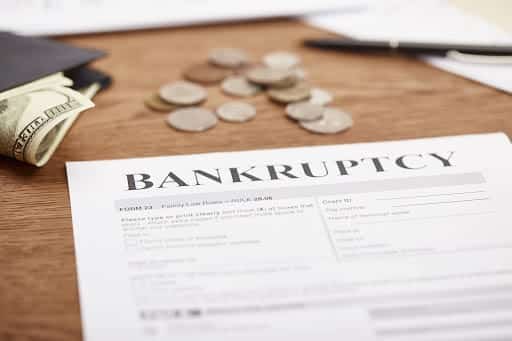Filing for bankruptcy provides a legal means of escape from overwhelming debt. Individuals and corporations alike frequently seek discharge from financial obligations through the legal system. The request is typically approved. Filing for bankruptcy allows you to either discharge your debts or reorganize them into manageable payments. However, the debtor typically initiates a bankruptcy case by submitting a petition to the bankruptcy court. An individual, a married couple, a company, or another legal body can all file a petition. In this article, we will discuss the pros and cons of filing for bankruptcy and what filing bankruptcy actually means.
Let’s get a strong grasp on what bankruptcy is before we dive into filing for it.
What is Bankruptcy?
Bankruptcy is a legal action that is started when a person or business is unable to satisfy outstanding debts or commitments. It aims to assist individuals and organizations in eliminating all or a portion of their debt or repaying a portion of what they owe.
However, it is more beneficial to view bankruptcy as a legal mechanism available when you or your firm are unable to meet financial obligations. Bankruptcy is one of the least understood debt relief solutions because of its complexity and stigma.
Furthermore, in a bankruptcy case, the assets and debts of a person, partnership, or company that has come to the conclusion that it cannot pay its bills are evaluated by a court-appointed trustee and judge.
Bankruptcy laws allow people and corporations to start over after financial hardship, but they have certain criteria.
Section 341 of the Bankruptcy Code requires debtors to attend a creditor’s meeting and submit specific financial information to the bankruptcy court and trustee, as well as complete more than 20 bankruptcy forms.
How Bankruptcy Works
By canceling out debts that can’t be repaid, bankruptcy gives a person or company a fresh financial slate. Meanwhile, creditors have a chance to recoup some of their losses through the sale of whatever assets are available.
Bankruptcy, in principle, helps the economy as a whole by giving individuals and businesses a second chance to rebuild their credit. This method can also aid creditors in recouping some of their losses.
In the United States, the federal government handles all bankruptcies. A debtor’s ability to file for bankruptcy and the debtor’s entitlement to a discharge are two of the many issues that a bankruptcy judge might decide.
A trustee, an officer designated by the United States Trustee Program of the Department of Justice to represent the debtor’s estate in the proceeding, is often responsible for administering bankruptcy cases. Unless the creditor raises an issue, the debtor and the judge rarely interact. When a debtor’s bankruptcy case has been resolved, they are released from their debts. Related Article HOW BANKRUPTCIES WORK (All You Should Know)
Important Bankruptcy Terms
You will need to be familiar with several bankruptcy-specific legal phrases if you plan to participate in the bankruptcy process. Some of the most typical and crucial ones are as follows:
#1. Bankruptcy Trustee
The bankruptcy trustee is the individual or company authorized to represent the interests of the creditors by the bankruptcy court. In Chapter 7 bankruptcies, he or she evaluates the debtor’s request, sells off any assets, and gives the money to the creditors. When a debtor files for Chapter 13 bankruptcy protection, the trustee is responsible for managing the repayment plan, collecting payments from the debtor, and distributing those funds to the creditors.
#2. Credit Counseling
You will be required to attend either an individual session or a group session with a non-profit agency that provides budget and credit counseling before you are eligible for filing bankruptcy. After you’ve submitted your paperwork, you’ll then be needed to finish a course on how to properly handle your personal finances in order to have the bankruptcy wiped. Both of these prerequisites could be exempt from fulfillment in particular scenarios.
#3. Exempt Property
Even though filing for either Chapter 7 or Chapter 13 bankruptcy could require you to sell assets to help repay creditors, there are certain kinds of property that could be exempt from this requirement. In general, things like work tools, a personal automobile, or equity in a primary property may be excused from a debtor’s obligation to give them up, depending on the state legislation that governs the situation.
#4. Means Test
If you wish to apply for Chapter 7 bankruptcy under the Bankruptcy Code, you have to prove that you truly cannot pay back your debts. The rule is there to prevent people from abusing the bankruptcy system. The test factors in things like regular income, assets, expenses, and unsecured debt. Depending on the results of the means test, a Chapter 7 bankruptcy case may be dismissed or changed to a Chapter 13 bankruptcy.
#5. Reaffirmed Account
Debts that may otherwise be forgiven in a Chapter 7 bankruptcy filing can sometimes be kept current with the debtor’s consent. If the debtor wants to maintain an asset (such as a car) that would be repossessed as part of the bankruptcy process, he or she can reaffirm the account and therefore agree to pay the obligation.
#6. Secured Debt
Recoverable debt is debt secured by an asset that can be taken back if necessary. In the case of a mortgage, the collateral is the house itself, and in the case of an auto loan, the collateral is the vehicle. If you fail to repay a secured loan, your creditors may attempt to repossess the collateral.
#7. Liquidation
The selling of a debtor’s property that is not exempt from being sold. After being converted into a “liquid” form (cash) through the sale, the assets are subsequently distributed among the debtors.
Who Declares Bankruptcy?
Bankruptcy is filed by people at a much higher rate than businesses, and this includes not only the wealthy who are trying to recoup losses from poor investment choices.
In 2022, businesses were responsible for only 13.4% of the total bankruptcy filings (387,721). Chapter 7 and Chapter 13 bankruptcy filers often have median annual salaries between $30,000 and $40,000.
It makes sense that individuals would file for bankruptcy as the great majority of bankruptcies are filed by individuals who have insufficient income to pay off large debts such as mortgages, credit card balances, automobile loans, or student loans.
Some people utilize bankruptcy as a long-term financial strategy to rearrange their debt. Arrested mortgage payments and back taxes are two examples.
People successfully utilize bankruptcy to block or postpone collection actions including foreclosure, repossession, and wage garnishment, despite the fact that it negatively impacts their credit and future financial options.
What Are the Consequences of Bankruptcy?
The most obvious effect of declaring bankruptcy is the loss of possessions. As was previously said, in either chapter of bankruptcy, you may be required to liquidate some or all of your assets to satisfy your creditors. For some people, filing for bankruptcy means giving away their home, car, jewels, and antique furniture.
It’s possible that your bankruptcy will have an effect on the finances of other people as well. If your parents co-signed a car loan for you, for instance, they may be held liable for a portion of the loan’s remaining balance even after you declare bankruptcy.
Bankruptcy, lastly, can lower your credit score. Having bankruptcy on your credit report will have a detrimental impact on your ability to borrow money in the future. Creditors may be hesitant to issue credit to you if they see a bankruptcy on your credit report, or they may offer you less favorable terms and interest rates if they do extend credit to you.
Furthermore, filing for bankruptcy can have a lasting impact on your credit score, perhaps for as long as ten years. Accounts that have been discharged will have their status changed to indicate that they have been discharged, and this change will be reflected in your credit report as well. In addition, a lower credit score can be the result of having negative information on your credit report.
What Does Filing for Bankruptcy Mean
Filing for bankruptcy provides immediate debt relief due to the automatic stay. That’s the statute that prevents creditors from contacting you after you file for bankruptcy. Additionally, it immediately halts pay garnishment.
It’s important to weigh the pros and cons of bankruptcy before filing. Many people have benefited from bankruptcy’s ability to discharge debt, but you must evaluate your own situation to see if this is the best course of action.
Alimony, child support, and recent taxes aren’t dischargeable in bankruptcy. Your bankruptcy will not shield your co-signers from liability.
A bankruptcy filing can’t be used to eliminate all debts, especially student loans. If you have federal student loans and meet the requirements, you may be able to get rid of your loan payments altogether in a Chapter 7 bankruptcy. It is possible to have private student loans let go, but doing so is usually sufficiently complex to need legal counsel.
Types of Bankruptcy Filing?
In the United States, bankruptcy petitions are filed under one of several chapters of the Bankruptcy Code. Liquidation of assets is the focus of Chapter 7 bankruptcy, while reorganization is the focus of Chapter 11 and debt payback is the focus of Chapter 13, which can feature lower debt covenants or individualized payment arrangements.
#1. Chapter 7
The most prevalent type of personal bankruptcy filing is Chapter 7, which calls for the debtor to hand over all of their non-exempt property to a trustee. Items such as furniture, clothing, and appliances are examples of personal property that are not subject to taxation.
The proceeds from the bankruptcy are distributed to the creditors in exchange for the cancellation of the remaining debt. Even if a debt is written off, the creditor holding the collateral (in this case, the car) can still exercise their right to repossess the vehicle.
A “means test,” which considers your income and debts, must be passed in order to qualify for this form of bankruptcy protection. Since the means test requirements are different in each state, it’s best to get legal advice from someone familiar with the laws in your area. Further, a person who does not meet the requirements for Chapter 7 bankruptcy may be bound to file under Chapter 13.
#2. Chapter 11 Bankruptcy
In Chapter 11 bankruptcy filing, companies can restructure in order to continue operations. When a business files for Chapter 11 bankruptcy, it gets a fresh start to focus on profitability by identifying and implementing cost savings and revenue growth opportunities. Common stockholders will be paid after any preferred stockholders, if any, are paid.3
However, a Chapter 11 filing cleaning firm, for instance, might consider raising prices somewhat and adding new services in order to turn a profit. While the company is working on a plan to repay its debts under the supervision of the court, it can keep operating normally under Chapter 11 bankruptcy. Only people in extraordinary situations should consider filing for Chapter 11 bankruptcy.
#3. Chapter 13 Bankruptcy
Chapter 13, often known as a wage earner’s plan, is an option for people who make too much money to apply for Chapter 7 bankruptcy. Individuals and enterprises with stable cash flow can use this to their advantage by working up manageable plans for paying down their debts.
Repayment plans typically consist of monthly payments spread out over three to five years. The debtors have the opportunity to keep all of their property, even nonexempt property, as long as they reimburse their creditors.
While Chapters 7, 11, and 13 constitute the vast majority of bankruptcies, there are a few others:
- Chapter 9 Bankruptcy. Municipalities such as cities, towns, villages, counties, and schools can file for Chapter 9 bankruptcy if they are experiencing severe financial difficulties. Under Chapter 9, municipalities can create a plan to gradually repay their debts rather than sell off assets.
- Chapter 15 Bankruptcy. For situations involving debtors, assets, creditors, and other parties located in more than one nation, the addition of Chapter 15 bankruptcy to the statute in 2005 was a welcome development. Usually, the home country of the debtor is where this kind of petition arrives.
- Chapter 10 bankruptcy. The corporate bankruptcy filing known as Chapter 10 was superseded by Chapter 11 in the late 1970s.
- Chapter 12. Family farms and fisheries can get some help from Chapter 12 bankruptcy. While they figure out how to pay back their loans, they can keep running their enterprises.
How To File Bankruptcy
After exhausting all other possibilities, you’ve come to the conclusion that bankruptcy, if filed and handled properly, could be a lifeline. Then what?
Understanding what not to do while filing for bankruptcy is just as crucial as understanding what to do.
When you declare bankruptcy, your debts may be discharged, reorganized, or reduced. The bankruptcy court has the final say on whether or not you get that chance. Most experts agree that hiring a bankruptcy attorney is the most practical option when filing for bankruptcy, although you can do it on your own if you want. Also, read HOW TO FILE BANKRUPTCY: Who Qualifies, What You Need to Know & Guide
There are legal fees and bankruptcy filing fees to consider. There may be free legal aid available if you can’t afford to employ a lawyer. The American Bar Association is a great resource for identifying low-cost bankruptcy attorneys and other legal aid organizations.
Get your facts straight before submitting. It’s not as easy as just saying, “I’m broke!” and pleading for forgiveness from the judge. Individuals and companies alike are subject to a process, which can be murky and convoluted at times.
Filing for bankruptcy entails the following steps:
#1. Gather Your Finances & Debts Documents
If you need encouragement to face your financial situation head-on, remember that this is the beginning of a new financial beginning. The day of your bankruptcy discharge is likely to arrive sooner than you anticipate. In addition, organizing your financial records and getting ready to file for bankruptcy can help you regain some sense of control over a situation that may otherwise feel out of your hands.
First, check your credit score for free. Each of the three major credit reporting agencies—Equifax, Experian, and TransUnion—will provide you with a free report once every year. The best place to begin learning about your financial obligations is in your credit report. Credit cards, credit lines, mortgages, auto loans, education loans, and even certain unsecured personal loans are all accounted for in this report.
However, it’s important to know that not all debts will show up on a credit report. Tax debts, payday loans, personal loans, and medical bills are typical examples. You should make a complete inventory of all of your debts, including those that do not appear on your credit report, before you begin the bankruptcy filing process.
Then, assemble the following documents:
- Two years worth of tax returns
- Proof of income for the last six months, such as pay stubs.
- Recent financial records
- Recent receipts from a brokerage or retirement account
- Appraisals and valuations of any and all real properties you own
- Registration documents in duplicate
- Other financial records, tax returns, and receipts
Many of these details will be necessary for you to accurately and thoroughly fill out your bankruptcy filing.
#2. Credit Counseling from an Approved Provider
A credit counseling course from an official agency is a requirement of all bankruptcy filers. You need to complete the course within six months before initiating your bankruptcy case by filing a petition with the Bankruptcy Court. Credit counseling must be completed by a company recognized by the U.S. Department of Justice.
Take this class to learn whether or not bankruptcy or another debt relief option is the right choice for you.
You can finish the training in approximately an hour if you do it over the phone or online. The cost of the course might be anywhere from $10 to $50. To qualify for a fee waiver, your household income must be at or below 150% of the federal poverty threshold.
Also, a completion certificate will be provided upon successful course completion. You should retain this certificate for future reference. A copy of this certificate must be submitted with your bankruptcy paperwork under federal law. In both Chapter 7 and Chapter 13 bankruptcies, the debtor is mandated to complete credit counseling.
#3. File for Bankruptcy with the Appropriate Forms
The paperwork required to file for bankruptcy is extensive. Because some of these papers are several pages long and there are more than 20 of them, your bankruptcy petition might be as long as 70 pages.
The bankruptcy paperwork requires full disclosure of all financial matters. In other words, those are your earnings, outlays, assets, and liabilities. This will assist the bankruptcy trustee and court evaluate your financial situation and determining if bankruptcy is a viable option for you. Details concerning your case, such as the type of bankruptcy you’re filing and whether you’re doing so pro se (on your own) or with a lawyer, should also be included.
If you hire a lawyer, he or she will fill out the paperwork for you according to the facts you give him or her. See if you qualify for Upsolve’s free filing software or make an appointment with a legal aid provider in your region if you can’t afford to hire a lawyer but don’t feel comfortable completing the papers on your own.
#4. Collect Your Document Filing Fee
Bankruptcy requires a petition to be filed with the court, and along with it, a $338 filing fee.
You can apply to pay your filing fee in installments after you’ve already filed your case if you don’t have the money to pay it all at once. You can ask for up to four installments per month.
Also, you can request a fee waiver if you are unable to pay the charge in full or even in installments. If your family’s annual income is less than 150% of the federal poverty level, you may apply for these benefits. The court has the last say on whether or not to waive your filing fees. This follows the filing of your bankruptcy paperwork. If the court rules against your request to have the cost waived, it will likely require you to make payments toward the amount.
#5. Get Your Bankruptcy Paperwork in Writing and Check It Twice
After finalizing your bankruptcy paperwork, you’ll need to have copies printed for the court. One side is the only option for printing on them. The court cannot process documents printed on both sides. After the forms are printed, you will need to sign them.
Get these ready:
- The petition paperwork, including any applicable local paperwork
- Proof that you’ve completed credit counseling.
- Paycheck receipts
- Your request for a charge reduction or payment plan (if any)
While only one signed original of the petition is needed by most bankruptcy courts, others may request extra copies. Make sure you have all the necessary local forms and find out how many copies you need to bring by calling your local bankruptcy court before you walk out to submit your documents.
#6. Submit Your Paperwork To The Bankruptcy Court In Your Area
A metal detector will be waiting for you once you enter the doors of your local courthouse, staffed by uniformed security officers. After you have cleared security, proceed to the clerk’s office and inform the clerk that you wish to submit a bankruptcy petition. They will accept your bankruptcy paperwork together with your filing fee (or your request for a fee waiver or payment plan, if applicable).
Don’t give the court access to your financial records or tax filings. After the case is filed, these papers are given to the trustee.
The clerk will begin working on your case while you wait by scanning and uploading your documents to the court’s electronic filing system. Typically, you won’t spend more than 15 minutes doing this.
The front desk agent will then call you back to collect:
- The case number for filing for bankruptcy
- Who will act as trustee in your bankruptcy case
- When and where your meeting with the trustee will take place (also known as the 341 meeting or the meeting of creditors)
Your claim has been submitted at this time! Congrats! The automatic stay puts an immediate stop to any further contact from creditors. This is fantastic news, but it’s not over yet. Keep moving on with the process.
How Do You Deal With Bankruptcy?
A bankruptcy filing doesn’t have to be a permanent setback. After declaring bankruptcy, there are steps you may take to begin rebuilding your financial life. Although the advice below may be useful, you should always seek the counsel of an attorney.
#1. Keep All Documents Associated With Your Bankruptcy Filing
It may not seem like a big deal now, but you should keep all of the documents associated with your bankruptcy filing. If you apply for a mortgage, a loan, or any other type of financial product in the future, you may be requested to provide proof of bankruptcy filings.
Debt attorney and founder of Tayne Law Group Leslie Tayne advises clients to have all relevant papers handy in case a lender or debt collector contacts them in the future over any of the debt contained in their bankruptcy file. What’s more, “you have proof if a debt collector contacts you about a debt you thought was discharged in bankruptcy,” the article says.
You should preserve records of the following documents:
- Documents concerning filing for bankruptcy
- Your petitioner’s supporting documentation shows proof of income.
- Safety-net programs Petitioners have submitted proof of income.
- Bankruptcy-related mail from the court, your lawyer, and the trustee
- The Closing of a Bankruptcy Case
#2. Initiate a Savings Plan
You don’t want to go through bankruptcy again just so you can avoid a repeat performance. You can take steps to prevent this from occurring by forming healthy financial habits, such as opening a savings account from which you can draw in times of need.
Tayne argues that learning financial management skills is crucial to a successful recovery. “Prevention is better than a cure,” as the saying goes. “Saving money helps you develop good financial habits for the future.”
Making frugality a habit is one of the best strategies to control spending and build wealth. To do this, you can establish regular, automatic deposits into a savings account.
Regardless of the size of your paycheck or other source of income, Freedom Debt Relief founder Sean Fox recommends setting aside a portion of your funds in a savings account. Save as much as you can from each paycheck, but choose an amount that you can manage easily so that you can keep up your savings over time.
Some companies allow workers to have part of their income deposited into a savings or investment account rather than their primary checking account. In addition, at some financial institutions, you can set up regular, automated transfers from your checking account to your savings account.
#3. Improve Your Credit Rating
Getting your credit back on track after bankruptcy is a major step toward financial independence. Regardless of the sort of bankruptcy you’ve filed, there are a number of approaches you can take to try to accomplish this.
- Make timely payments. Since your payment history constitutes 35% of your total FICO credit score, paying all of your bills on time is one of the greatest ways to begin repairing your credit. Pay off any leftover debt promptly to demonstrate that you can be relied upon financially.
- Establish a secure credit line. After a bankruptcy discharge, you may find yourself in need of new credit because you no longer have any outstanding loans or debts on which to demonstrate financial reliability. Opening a secured credit card is one option for getting started with credit. These credit cards require you to have a savings account in your name as collateral. Your secured credit card’s spending limit is often determined by the amount of money in your savings account, which also serves as collateral for the card. Regularly making on-time payments on the secured card will assist you in reestablishing a good credit history. If you make your payments on time for a while, the credit card company may give you a regular credit card.
- Credit-establishing loans. The money from these loans is put straight into the account of the one who takes them out. While you use that money to pay off the loan’s principal and interest, the lender will hold onto it. The credit bureaus will have access to your payment history.
#4. Create an Emergency Fund
In the midst of bankruptcy, this cash can be crucial. However, in order to stay out of debt in the long run, you should have three to six months’ worth of emergency funds saved up.
In addition, filing for bankruptcy is an involved and serious matter. In order to get your financial home in order, you need to weigh the benefits of bankruptcy against its drawbacks.
#5. Keep an Eye on Your Credit Reports Frequently
After a bankruptcy, it can be nerve-wracking just to think about pulling your credit report. Nonetheless, you should make it a habit to do so on a regular basis. Checking your reports on a frequent basis can help you verify the accuracy and completeness of your profile. Your score may be lower than it should be if some of the information you provided was incorrect.
Tayne warns that having discharged debt still appears on credit reports as ongoing debt could hurt your score.
It may be difficult to resolve the issue if it has been mistakenly moved to a new debt-collecting agency.
If there is a mistake on your credit report, you need to alert the credit reporting agencies and the company that provided the incorrect data. Write a letter outlining the situation and attach the credit bureau’s dispute form and supporting documents. Always keep a record of your correspondence.
The credit reporting agencies are required by law to look into your dispute within 30 days of receiving it.
The reporting company will receive copies of all supporting documents. If the company discovers that the data it submitted is incorrect, it must contact all three bureaus so that the data can be updated. If your dispute changes your credit report, the credit bureaus must send you a free written copy.
You may do free credit report monitoring online. Each of the three major credit reporting agencies offers a free credit report once a year. Use a free online credit monitoring service, such as Bankrate, or activate your bank’s fraud alarm system.
#6. Set Financial Goals
Do you hope to someday be a homeowner or a car owner? Or maybe you should just go back to school? Financial stability and continued savings contributions are both facilitated by having such long-term objectives in mind following bankruptcy.
Part of being financially secure is making plans for the future and maybe even writing them down. Making a detailed, workable plan is essential for reaching your financial objectives. In addition, defining goals can facilitate the subdivision of a massive, intimidating objective into more attainable sub-goals.
It’s a good idea to plan for your financial future by setting goals both near and far. Your medium-term goals are something you can work on over time, whereas your short-term goals require immediate attention. Saving for retirement and other distant aspirations constitutes a long-term financial objective.
Once you’ve set long-term goals and written them down, good money habits will help you reach them.
Pros and Cons of Filing for Bankruptcy
Filing for bankruptcy is a last resort, but for those who are drowning in debt, it can be a lifeline. Take a look at some of the pros and cons of filing for bankruptcy.
PROS
#1. You Get an Automatic Extension of Your Stay
The second you file for bankruptcy, the automatic stay goes into effect, shielding you from creditors. Your medium-term goals are something you can work on over time, whereas your short-term goals require immediate attention.
#2. Creditor Management Will Be Easier
The stress and anxiety resulting from dealing with numerous creditors can be lessened by filing for bankruptcy protection. In fact, once your debts disappear and you are no longer responsible for making payments on part or all of your bills, you may feel immediate relief.
#3. Insolvency Can Stop Lawsuits From Continuing
If you file for bankruptcy, you may be released from the legal obligation to repay your debts. In addition, it might forestall any legal issues that may arise from the debtor’s continued refusal to pay. Keep in mind that bankruptcy will wipe out most of your outstanding consumer debt, but not all.
#4. In Some Cases, Filing for Bankruptcy Can Stop a Foreclosure or a Repossession
Filing for Chapter 13 bankruptcy may help you postpone or perhaps prevent repossession of your vehicle or home. If you qualify for an exemption, you may also be able to keep your car.
For instance, the federal government exempts up to $4,450 in automobile equity. Also, if your car is worth less than $4,000, you may be able to keep it because of a government exception.
#5. It’s Possible to Negotiate a Debt Settlement That Reduces What You Owe
Creditors have no choice but to accept the outcome of your bankruptcy case, which may be receiving nothing at all. Chapter 7 bankruptcy can remove unsecured debt like credit card, personal loan, and medical bill debt.
Chapter 13 bankruptcy, on the other hand, might be more difficult since you may be required to make payments on certain of your debts over a period of three to five years.
CONS
#1. Valuable Possessions May Be Lost
It’s possible to lose your home, car, and other valuables in bankruptcy, and the amount you lose depends on the type of bankruptcy you file for, your income, the equity in your assets, and other considerations. In order to satisfy your debtors, your trustee may have to liquidate these assets.
#2. Filing for Bankruptcy Can Be Very Costly
Bankruptcy is not free; you’ll have to pay for things like court and service fees. The average out-of-pocket expense for a Chapter 7 bankruptcy case is roughly $1,750, while the average for a Chapter 13 bankruptcy is around $3,300.
#3. Filing for Bankruptcy Might Take a Long Time
Discharge in a Chapter 7 bankruptcy is usually granted within a few months of filing. In contrast, Chapter 13 bankruptcy requires you to stick to a payment plan for three to five years before your case is discharged, making it a significantly more time-consuming procedure.
#4. Bankruptcy Can Affect Your Career or Work
It’s hardly common, but bankruptcy can prevent you from being hired for some jobs. A bankruptcy filing is most likely to hurt accountants and payroll workers. Since bankruptcy filings are public record, prospective employers may discover them when doing employment credit checks.
#5. You’ll Have a Tough Time Getting Credit in the Future
The effects of filing for bankruptcy are long-lasting. A bankruptcy filing can remain on your credit report for up to 10 years if you filed under Chapter 7, and for up to 7 years if you filed under Chapter 13. Lenders may reject your application for credit if they perform a credit check and discover your bankruptcy.
Conclusion
Although filing for bankruptcy can help you start over financially by discharging debts you cannot afford to pay, it is not without costs. It may be more challenging to obtain loans in the future if you have a bankruptcy on your credit report.
Debt consolidation programs and renegotiating new repayment conditions with your creditors should both be explored before filing bankruptcy. Talk to a financial advisor if you need assistance determining which option is best for your own financial situation.
Filing for Bankruptcy FAQs
Who gets paid the last in case of bankruptcy?
In most cases, the order of priority for creditors is as follows: secured creditors come first, then priority unsecured creditors. Equity stockholders often receive payments after all other creditors have been satisfied.
Do you get money back from bankruptcy?
Even though it’s never good news when a business to whom you’ve sold goods or offered services declares bankruptcy, you may be able to recover some of your losses. You’ll need to submit a proof of claim quickly so the trustee in charge of paying off creditors can add your debt to the list.
Similar Articles
- TOP DIGITAL WALLETS IN 2023: How They Work
- Fixed Index Annuity: How It Works (Pros and Cons)
- DIVORCE SETTLEMENT: Top 15+ Financial Mistakes to Avoid in Your Divorce Settlement
- FREE CREDIT SCORE: How to Check My Free Credit Score (+Best Free Credit Score Sources)
Reference
- investopedia.com
- debt.org
- upsolve.org
- experian.com
- businessday.ng
- businessnewsdaily.com
- forbes.com
- lendingtree.com
- bankrate.com
Pros and Cons of Filing for Bankruptcy






